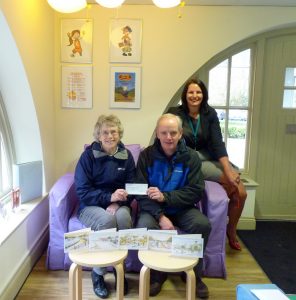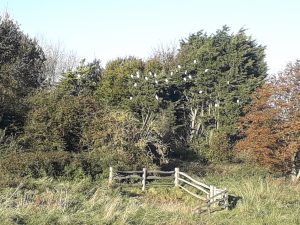Chairman of the Group, David Bettiss, and Tricia Hall visited the local Chestnut Tree House Children’s Hospice to present their fund raiser Caroline Roberts-Quigley with a cheque for well over £700 – this being the proceeds for the seventh year running of the sale of Christmas cards produced by the Group. Over these years, thousands of pounds have been raised for this excellent cause.
Group Meeting – 23rd February 2018
At their end of February meeting at the Village Hall, members of Ferring Conservation Group were entertained by guest presenter, Graeme Lyons, who is the Senior Ecologist at the Sussex Wildlife Trust. He was intending to talk about the Invertebrates of the SWT Reserves, but a late change of plan led to him presenting his Top 100 Wildlife Highlights in Sussex, which happened to consist of around 80% invertebrates.
Graham who also happens to be the County Recorder of Spiders, as well as in his own words – “Bugs”, counted down his highlights from number 100 to number 1 all in the space of an hour. This was packed with useful information, and included among others beetles, spiders, dragonflies, butterflies, moths, fungi, fish and birds, and all of these had been seen in the County.
He illustrated his talk with some excellent close up photos, and some other distant shots which by his own admission were taken on the spur of the moment, including a quail that was just disappearing out of shot! The names of various species were just as entertaining – the Wart Biter cricket, the Strawberry spider (which looks just like one), the Purse-Web spider (our only Tarantula) and even the interestingly named Bastard-Toadflax Shieldbug.
The top three of his 100 were at number 3 – the Portuguese Man 0’War jellyfish seen on the beach at Portslade, number 2 – the Crimson Speckled moth, and finally at number 1 – Calosoma Sycophanta, an incredibly rare flying beetle seen by him in a field near Bishopstone in East Sussex, which was the first recorded sighting in Sussex since the 18th Century.
To conclude the meeting, Tricia Hall presented her Nature Notes, which included the first sightings of the year of frog spawn, and Ed Miller updated members on planning matters, which included the welcome news that the appeal against Arun District Council’s refusal of the plan for 23 Yurts and associated buildings on the southern slopes of Highdown had rightly in our opinion been turned down.
Waste cooking oil, greener energy and blocked drains?
How many of us would make a connection between used cooking oil as a source for cleaner energy and fewer pounds spent on cleaning and repairing drains and sewage treatment plants? The connection might not be that obvious but there is a connection and a very costly one.
It is estimated that each year in the UK 129 kilotonnes of used household cooking oil is disposed of and most of it goes down the drain. Cooking oil can and is being used to provide green, carbon neutral electricity. A litre of oil can generate sufficient energy for 240 cups of tea, or 5 hours of microwave use, or 160 hours of laptop use.
When cooking oil is improperly disposed of it is harmful for the environment and water companies have to clear blockages. 115 tons of waste was removed from the treatment plants of East Worthing and Shoreham between April and November in 2014. Money is spent unblocking, cleaning and removing waste oil and other items such as ‘flushable’ wet wipes from drains and sewage treatment plants. Southern Water cleans and unblocks drains and sewage plants because householders put oil, fats and other inappropriate items down drains and toilets.
Recycling used cooking oil for renewable electricity will, in the long run, save us all money. Recycling even a small amount of waste oil including vegetable oil from sun-dried tomato jars, fry-ups and tinned tuna oil, can be used for producing biofuels, help to lower carbon emissions and help keep the drains and sewers unblocked.
The Household Recycling Waste Centres in Worthing, Shoreham and Littlehampton provide residents with opportunities for the recycling of almost all disposable items, including waste cooking oil. For each visit to these Recycling Centre residents may recycle up to 5 litres of used cooking oil in the disposal tanks provided. The bulk of the oil safely disposed of is used to generate a sustainable energy source.
There are many examples of good and emerging reduce, reuse and recycle schemes.
Surrey Council invites catering outlets to donate used cooking oil for the production of biodiesel and in Kingston on Thames the Council offers a free cooking oil collection service as well as an offer to buy large quantities of cooking oil for reuse as biofuels. In Milton Keynes there are commercial collection points for waste oil to be reused for cleaner electricity. Huntingdon District Council provide a collection of all food and garden waste which is then reused for compost. West Sussex uses the bulk of recycled oil from its Recycling Centres for the production of greener electricity. Householders can contribute to this free of charge but catering outlets have to pay for safe disposal of waste cooking oil.
There could be opportunities for the water authority and councils to negotiate more effective processes for the reuse of waste cooking oil and other reusable substances. Savings could be used to offset council costs and reduce treatment and sewer maintenance costs. Communities can work alongside councils and other providers to improve the effectiveness and reduce the cost of the services available.
The message of reduce, reuse, recycle is still valid. By acting responsibly with what is put down the drains and what is recycled local residents can support the generation of cleaner energy and save money on drain cleaning operations.
Sources
1. Article on drains and ‘sewer – blockers’ (the public’s help in maintaining effective drainage systems). Worthing Herald 29th Jan 2015
2. West Sussex Gazette 14th January 2015. “Waste oil helps to generate energy”. Various eco/ biofuel websites and council sites.
3. Various eco/ biofuel websites and Council sites
4. London Oils ~ free collection of oil in Essex, Norfolk, Suffolk
By Lesley James
Conservation Work continues in Ferring
Members of Ferring Conservation Group have recently been carrying out more practical work in the village in order to improve our local environment and particularly to make it a more welcoming place for our wildlife.
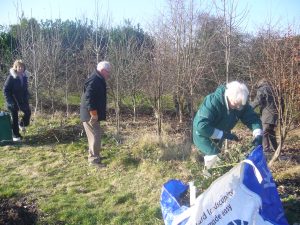 In the first of our regular monthly small work parties, a number of members met at the Glebelands Recreation Ground in the centre of the village to carry out some practical work around the Community Orchard. The main task was to cut back the invasive brambles that had grown up in the small copse of trees that back on to the fruit trees themselves and had threatened to overwhelm them. This was completed quickly and efficiently, and without too many scratches from the enormous thorns! The trees will be very grateful for the removal of some of the competition.
In the first of our regular monthly small work parties, a number of members met at the Glebelands Recreation Ground in the centre of the village to carry out some practical work around the Community Orchard. The main task was to cut back the invasive brambles that had grown up in the small copse of trees that back on to the fruit trees themselves and had threatened to overwhelm them. This was completed quickly and efficiently, and without too many scratches from the enormous thorns! The trees will be very grateful for the removal of some of the competition.
The Group has also arranged the installation of a large Tawny Owl nest box and a slightly smaller bat box in the copses at the Little Twitten Recreation Ground, just off Sea Lane.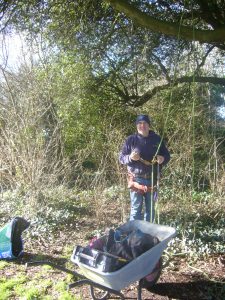
The Owl box had been in place at the Warren Pond in the village, but it hadn’t been successful and it was felt better to move it to a location where Tawny Owls have been heard on a regular basis. It was quite a technical task to mount it in a suitable tree, and the services of an excellent local tree surgery company, Mr Tree (based in Worthing), were required to complete the job safely. Proper climbing equipment was deployed the tree surgeon, Shane Jones, and he was able to abseil back down to ground level when he had finished.
The bat box had been donated by two of our committee members, Lindsey and Chris Green, and this was fixed to a suitable large Sycamore tree in another part of the Recreation Ground.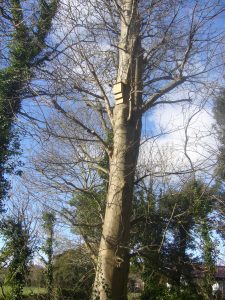
Time will tell, but we hope that the local Tawny Owls and bats approve of what we’ve done for them, especially as their natural nesting sites are reducing in number and suitability. We’ll be keeping an eye on the boxes, which are in addition to the significant number of smaller nest boxes that we’ve already put up around the village (thanks are due to committee member Graham Tuppen for refurbishing many of the boxes this Winter) , and we’ll be reporting on any developments.
The next of the monthly work parties will take place from 10am on Tuesday 6 March, meeting on the Village Green. The task will be to cut back some of the bushes and generally tidy up the area that we look after. Please bring secateurs and loppers if you have them, and wear suitable clothing.
Group Meeting – 26th January 2018
Glyn Jones gave a talk to Ferring Conservation Group [on 26 January] on the work of the South Downs Society, trying to protect the Downs from development while opening them up for recreation and quiet enjoyment of the landscape and other heritage assets. The Group was founded in 1923, as the Society of Sussex Downsmen, and its major achievement was its successful lobbying for the creation of the National Park, long promised but only implemented in 2002. Since then, he said, the Society had tried to be a ‘critical friend’ of the South Downs National Park Authority, offering advice and public engagement, and campaigning for the defence of the Downs in a way that the SDNP could not do, as a government body.
Glyn, a retired National Trust Ranger, clearly knew the Downs from Winchester to Eastbourne like the back of his hand, and illustrated his talk with many images – familiar and unfamiliar – of the chalk hills, beautiful villages, ancient hill-forts, modern farming, wildlife and people enjoying the landscape in many different ways. He pointed out that the National Park included valuable heathland, such as around Midhurst, where the plants and animals were quite different from those of the Downs themselves. Lizards and even adders could still be seen there, although the adder population was declining.
He ended his talk with a survey of the continuing threats to the Downs, even with their National Park status – fracking wells had been banned in the Park but not necessarily horizontal drilling from outside; major road schemes, like the A27 at Arundel; and on-shore wind farms. By contrast, the developers of the Rampion off-shore wind farm had worked very closely with all concerned to minimise the intrusion of the turbines and restore the landscape temporarily marred by the on-shore cabling.
After a break for tea Graham Tuppen delivered the popular Nature Notes slot and began by informing us that some welcome signs of spring with Snowdrops, Crocuses and Daffodils were all evident in sheltered places and also Hazel catkins had appeared on trees in Sea Lane. Thrushes and Robins had begun singing and Tricia Hall had reported spotting a Water rail in her garden, with a further six seen on the Rife along with a solitary Brent Goose. It had been reported that Foxes had been enjoying the winter sunshine by laying on garden shed roofs and Wood mice had been viewed feasting at bird feeders.
Ed Miller concluded the January meeting with news that ASDA had submitted a planning application for a Petrol Station and Jet Wash on the North East corner of their Ferring store. Ed advised us that the decision on the four detached houses proposed at 32/34 Sea Lane had been delayed, while the proposed additional apartment at Southpoint on the old Beehive Cottage site had still to be decided. The 23 Yurts proposed at the foot of Highdown are still awaiting a decision on appeal, and the four bungalows proposed at 44, Ferringham Lane were awaiting a decision by Arun DC in March of this year.
New monthly work parties
Starting in February, we will now be organising monthly work parties for anybody interested to help out at the various locations around the village where carry out practical activities to maintain and improve the local natural environment.
These will always be held on the first Tuesday of the month between 10am and midday. Details of the exact location to be covered and the meeting point will be advertised here as well as at the members meeting at the end of the previous month. We will still be carrying out our various clean ups including beach cleans and other fiixed activities such as the annual clear up of Warren Pond with Ferring Parish Council as separate matters.
We hope to see some of you there, even if you can’t stay for the whole session. If bad weather is forecast, please check this website in case of cancellation.
Group Meeting – November 2017
At our last meeting of the year we welcomed Anne Weinhold who educated us regarding a two-year Heritage Lottery funded project entitled ‘The Last Fisherman Standing’. This inspiring project is run by social enterprise ‘We are FoodPioneers CIC’ and aims to protect and celebrate the heritage of our oldest maritime trade in Worthing. Under this umbrella many community events are available including courses, talks, exhibitions and the opportunity to get involved with pop up fish markets, museum workshops and cookery events.
Since the 16th century fishermen have been fishing off the beach at Worthing and during the 19th century the industry expanded with the help of improved roads with fish being sent to nearby towns. In 1849 twenty five boats were operating along this stretch of the coast and in 1887 around ninety three men and seventeen boys were recorded working in the fishing industry.
However, during the latter years of the 20th century, fewer and fewer boats were seen going out to sea from Worthing and the fishing fleet quietly began to disappear. The fishermen that remain now fish from harbours such as Shoreham utilising larger boats and therefore are able to increase their catch albeit in accordance with official quotas.
This Project strives to protect the heritage of our fishing families in Worthing by recording and reviving the fishermen’s tales and sharing their vast knowledge of the sea on our doorstep and celebrate their contribution to the town. A former fisherman, Norman Bashford, a member of the oldest fishing family in Worthing and now in his 80’s, has been so inspired by the Project that his daughter and her partner have now started fishing off of Worthing beach in their own boat. To find out more about this project please visit: www.lastfishermanstanding.org.uk
After tea and mince pies we were interested to hear from Tricia Hall, during her Nature Notes presentation, that Meadowsweet is still in bloom along the banks of the Rife and Cosmos is in flower and attracting bees in Tricia’s garden. Graham Tuppen and Tricia have jointly visited and cleaned out the nest boxes sited around the village. They reported that there was evidence that all except one had been used during this or last year’s nesting season.
Ed Miller concluded the meeting with the news that a planning application had at last been submitted to Arun DC for the renovation of one existing property and the building of four properties at 32 and 34 Sea Lane, Ferring. The closing date for comments for this application is 21st December 2017. Ed also commented that the Arun DC Local Plan was still with the Planning Inspectorate.
FCG Southdowns Bird Walk 31st October 2017
With ideal weather conditions on our side members of Ferring Conservation Group met at Michelgrove Lane on the Angmering Park Estate, in the hope of seeing a variety of bird life. We were not disappointed. This private estate extends to over 6,750 acres and is owned by the Trustees of the late Bernard, 16th Duke of Norfolk with its origins going back to the Norman Conquest.
As we made our way along the lane towards Harrow Hill, pausing to hear the distinctive call of Pheasants, we sighted both male and females foraging in fields along with Jackdaws and Ravens. As a Great Spotted Woodpecker flew past we noticed Hazel catkins, Blackthorn berries, commonly known as Sloe, wild Rose-hips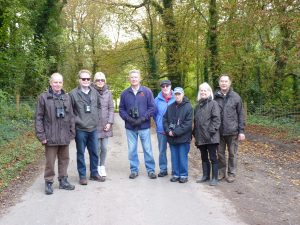 , Field Maple, Dogwood and Ash lining the edges of the lane. Walking further up the Downs a Buzzard could be heard calling and then appeared on the horizon pursued by two Crows. A shrill call alerted us to a Skylark perched on telephone wires, a Corn Bunting, several Meadow Pipits, a Chaffinch and a Song Thrush were also seen in the vicinity.
, Field Maple, Dogwood and Ash lining the edges of the lane. Walking further up the Downs a Buzzard could be heard calling and then appeared on the horizon pursued by two Crows. A shrill call alerted us to a Skylark perched on telephone wires, a Corn Bunting, several Meadow Pipits, a Chaffinch and a Song Thrush were also seen in the vicinity.
After negotiating two stiles and a particularly slippery footpath, Black Patch Hill came into view and Common Gulls, Partridge, including Red-legged Partridge, Stock Doves and Woodpigeon were seen in distant fields, and silhouetted against the skyline three Buzzards were seen perched in a tree. As we turned to make our way back we were rewarded with the sight of two Red Kite circling high above us pursued by Crows, and a Kestrel hovering over a field searching for prey. Having once again found our way back to the lane a Chiff Chaff and three Goldcrest were spotted in the bushes. As we neared our starting point a Stoat crossed the lane directly in front of us and quickly disappeared into the undergrowth, adding yet another interesting sighting to our morning.
Together with the more common birds we noted some 25 species as well as several Red Admiral butterflies along the way. We thanked our guide, Clive Hope, for an enjoyable and informative walk and we all agreed this was a worthwhile exercise.
Little Egrets spotted by the banks of the Rife
A Walk around Horsham
On a blustery October morning around 20 members of Ferring Conservation Group met at Horsham Museum for a guided tour to discover some of the hidden secrets of this historic town with our guide for the day, Patricia Hall. This walk followed the trail in the book written and beautifully illustrated by Patricia about Horsham, entitled ‘Armchair Walks in Sussex’.
Patricia began by explaining that the name Horsham comes from ‘Horse Meadow’; a place where horses, cattle and sheep could graze in clearings in the forest.
The impressive Town Hall was our first stop and Patricia captured our imaginations as she described a scene from Elizabethan times when the ground floor was an open arcade and various stalls selling poultry, butter and such like produce was known as the ‘Market House’. The upper floor was where the County Court sat. The ten small ‘holding’ cells in the basement still exist although their windows are now bricked up. The Market House was rebuilt in 1812 by the Duke of Norfolk and his coat of arms can be seen on the front wall.
As we turned into the entrance of Pump Alley, one of several narrow alleyways, we noticed the hinged, wooden letter box on the wall at the site of Horsham’s first Post Office. It was here that letters could be handed directly to the postmaster who sat behind.
We retraced our steps and turned into a pretty road called ‘Causeway’, Patricia pointed out a wall plaque on number 8 Causeway which commemorates the War Hospital Supply Depot. This was established in 1915, during the First World War, to collect materials for hospital use to send to war zones in Europe.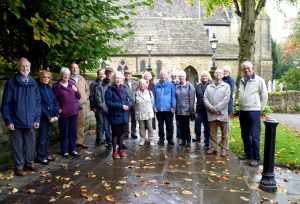
Jane Hayman from the Group said “As we strode along Patricia encouraged us to turn our attention to the skyline and note the many diverse styles of architecture which makes this lovely town so special. We were also made aware of the many houses in the Causeway that employ large slabs of sandstone in their roofs extracted locally and known as Horsham Stone or Slates’.
The Museum is not only a beautiful medieval timber-framed building but also houses many fascinating artefacts. The Blazing Saddles room at the rear displayed a variety of bicycles, an old fire engine and also the unique ‘Pentacycle’, invented by a Horsham business man but unfortunately it was not a success. Crime and Punishment is the theme to another of the exhibitions, displaying keys, handcuffs and truncheons from the County Gaol which was demolished in 1845. As we turned into Morth Gardens we noticed the pretty cottages and then turned right into Denne Road and pass Drill Hall and the Lychgate to Denne Road Cemetery on our way to St Mary’s Church. The tall church spire is 156 feet high (nearly 48 metres) and has over 50,000 shingles (wooden tiles) as these are lighter than traditional tiles.
Once again we retraced our steps and headed along the Causeway back to the Museum and completed our walk at our starting point. As we thanked Patricia for a very enjoyable and informative walk, we all agreed that Horsham is indeed a lovely town with considerable historic interest.

